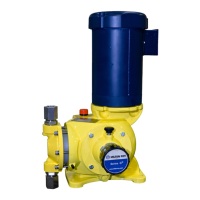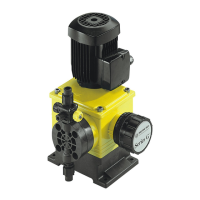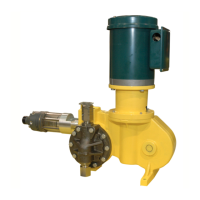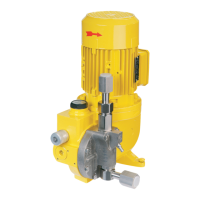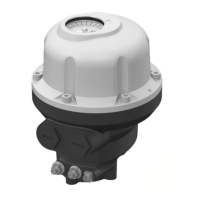9
2.6.3 SUCTION PIPING CONSIDERATIONS
It is preferable to have the suction of the pump ooded by locating the liquid end below the lowest level
of the liquid in the supply tank.
To minimize the chances of a loss-of-prime condition, the pump should be installed as close as possible
to the supply vessel.
Avoid negative suction pressure conditions (suction lift), as such conditions adversely affect metering
accuracy. A lift of 2 meters of water column is the maximum permissible suction lift.
Series G pumps are designed to operate with process liquid supplied at or above atmospheric pressure.
Although these pumps can move liquids supplied at less than atmospheric pressure (suction lift), in
these negative pressure applications it is important that all connections be absolutely drip free and vac-
uum tight, and that a foot valve be installed at the bottom of the suction line (see upper left illustration of
Figure 2-2).
When pumping a liquid near its boiling point, provide enough suction head to prevent the liquid from
"ashing" into vapor when it enters the pump liquid end on the suction stroke.
If possible, use metal or plastic tubing for the suction line because tubing has a smooth inner surface
and can be formed into long, sweeping bends to minimize frictional ow losses.
A strainer should be used in the suction line to prevent foreign particles from entering the liquid end.
This and any other measures which prevent debris from entering and fouling the liquid end check valves
will give increased maintenance-free service. Check strainer frequently to prevent blockage which could
lead to cavitation. Keep suction piping as short and straight as possible.
Piping size should be larger than the liquid end suction tting to prevent pump starvation.
If long suction lines are unavoidable, install a stand pipe near the pump in the suction line.
Suction piping must be absolutely airtight to ensure accurate pumping. After installation, test suction
piping for leaks with air and soap solution.
2.6.4 DISCHARGE PIPING CONSIDERATIONS
Install pipe large enough to prevent excessive pressure losses on the discharge stroke of the pump.
Maximum pressure at the discharge tting on the liquid end must be kept at or below the rated pressure
(shown on the pump nameplate).
The pump will not deliver a controlled ow unless the discharge line pressure is 10 psi greater than the
suction line pressure. One way to create an articial pressure is the installation of a back pressure valve.
(Please contact your dealer for recommendations to increase back pressure in slurry applications).
When pumping water treatment chemicals directly into boiler drums, use one liquid end assembly for
each boiler drum. Discharging into a manifold having the slightest pressure difference between its
several discharge connections can diminish metering accuracy as the outlet with the lowest pressure
will receive more liquid than the other outlets.

